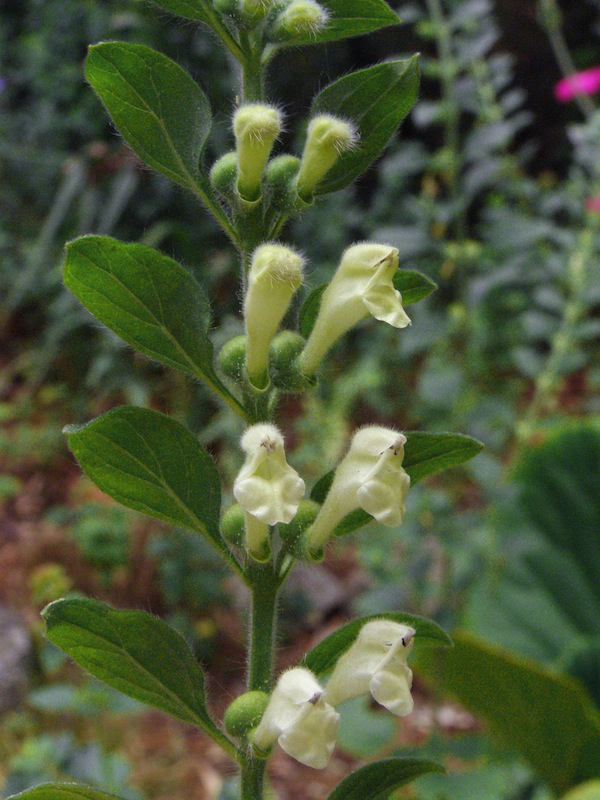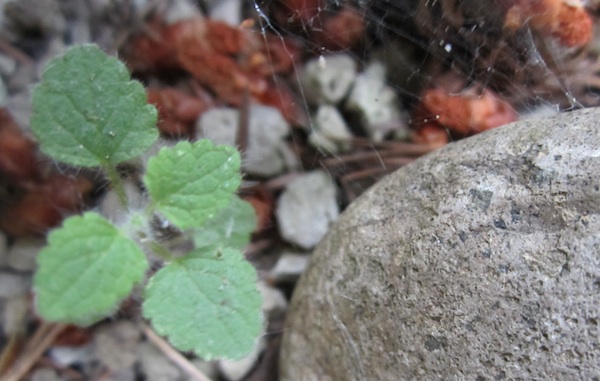Plant of the Month: November 2012
|
| Turkish White Skullcap; |
| Scutellaria albida L. 1771 |
| = Scutellaria pallida M. Bieb. 1808, non Guss. 1828 |
LABIATÆ; Mint Family
|
| Sometime in the 1990s, a plant appeared mysteriously in my Seattle garden. Whether it was a random seedling, or had been brought in as a tiny stowaway on a plant that I had acquired, is unknown. Eventually, it grew large enough, produced flowers, set seed, and then I tried to identify it. When finding a plant whose geographic origin in utterly unknown, that is not simple. None of my visitors knew its name. |
| It sure resembled the Scutellaria genus, commonly called skullcap. So, assuming for the sake of ease that it was one such, I began checking books. First I tried local Pacific Northwest books. Failing to find it in them, I tried other North American books. No luck. Next I tried European books. Finally, I came up with a tentative identification, using Flora Europaea. This was verified in the Flora of Turkey. Therefore, in the second edition of my book Wild Plants of Greater Seattle, the mystery plant is listed on page 446 as Turkish White Skullcap, "Perennial E Mediterranean weed; reseeds." |
| All Scutellaria species are perennials or rarely shrubs that grow in most areas of the world other than the Amazon basin, lowland tropical Africa, S Africa, the Pacific islands, Central Asian desserts. According to the online Plant List operated from the Royal Botanic Gardens, Kew, 461 Scutellaria species are currently accepted. Two are native in Seattle. |
| The vast majority of plants in the mint family bear square stems, opposite leaves, and are more or less strongly aromatic, often pleasingly so. Scutellaria tend to be scentless or ill-scented, and the Turkish White Skullcap is --alas-- a good example. In that regard, it recalls many Stachys and Lamium species. Moreover, unlike the two Seattle natives that favor wetlands, it grows in dry, sunny areas. And whereas most Scutellaria species bear pink, red, blue or purple flowers, it has creamy white ones. So it is sort of a nonconformist, a fact that I appreciate. Conformity can be boring. |
| In my garden, Scutellaria albida is a plant of robust strength; blooms yearly each summer, and reseeds successfully. Its softly hairy foliage is visually dull and inelegant; its flowers are at best of a subtle charm, viewed up close. And so, I would have dug up the plant and composted it, except that around 2009, my friend botanist Peter Zika saw something or other about it that seemed to indicate my i.d. was wrong; that it was not, in fact, Scutellaria albida. |
| So, for the sake of scholarship, I permitted the plant and its offspring a stay of execution, awaiting positive confirmation. In 2007, Randall Hitchin, from Washington Park Arboretum, had visited, saw my weird skullcap, and declared that it was also a weed in his Seattle garden. And he knew not its name or origin. So here we had two cases of a similar nature. |
| Peter sent herbarium specimens of the plant from my garden to experts around the world. This month, a reply came from Dr. Mehmet Çiçek, Pamukkale University, Arts & Science Faculty, Denizli, Turkey. The plant is, after all, Scutellaria albida. |
| The purpose of this little article is to point out that it seems to be a case that heretofore no one has written that this species can be weedy in North America. It reseeds in garden settings, even in Seattle's dry summers, within unirrigated spots. That suggests that it could escape gardens and run wild. |
| Since Scutellaria albida tastes horribly bitter and is neither edible nor aromatic, and minimally ornamental, I did a web search to learn if it has been used in medicine or had other interesting aspects. As far as I have learned, only five Scutellaria species have ever been recorded as edible, though many are used medicinally. |
| I learned that the species is highly variable; its flowers can be yellowish-white. It was cultivated intentionally in England by at least 1771. It has been scarcely mentioned in books describing ornamental garden plants. For example, it is in the 1976 Hortus Third, and Linda Fox's 1978 book Encyclopedia of Garden Plants; but is unmentioned in the 2000 or 2011 European Garden Flora. It has been grown in Pennsylvania since at least 2008. It is offered by at least one English and one Welsh nursery. It has been, and is being, investigated for medical action, though so far is nowhere near as useful as Baikal Skullcap, S. bailcalensis Georgi [huang qin]. |
Its native range extends from SE Europe (NW Italy) to Ukraine and the Caspian Sea. There are subspecies that vary in appearance and geography; I am writing here only about the typical Scutellaria albida.
Back
|

Scutellaria albida flowers; photo by Peter Zika
|

Scutellaria albida November foliage; photo by ALJ
|

Scutellaria albida seedling; photo by ALJ
|
|
|

